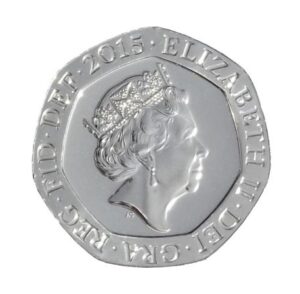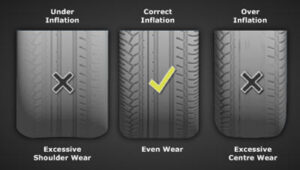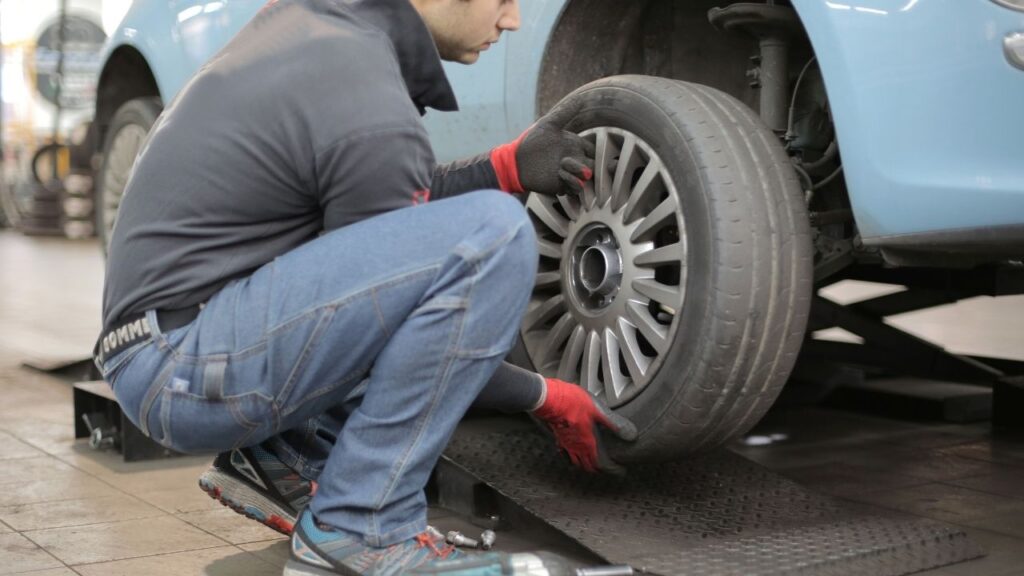Tyre condition
Tyres – It doesn’t matter how good your brakes are as they don’t connect you to the road, this is all down to your tyres, but we all know we don’t check them as often as we should.
Tyre depth – the minimum tread depth in the UK is 1.6mm and tyres start their lives on cars with 8 mm doesn’t seem like a lot but it makes a lot of difference, it is recommended that you shouldn’t let them go below 3 mm.
When checking these you can see wear bars between the tread.
 A good way to check them if you don’t have a depth gauge is to use a 20 pence piece the rim is 3mm depth, so place this between the tread and if the rim can not be seen the tyre has more than 3mm tread.
A good way to check them if you don’t have a depth gauge is to use a 20 pence piece the rim is 3mm depth, so place this between the tread and if the rim can not be seen the tyre has more than 3mm tread.
You should also check the sidewalls of the tyre for any cuts or bulges in the tyre because if a cut exposes internal cords it could be dangerous.
The same for a bulge as this means it has normally hit something and broken down the internal structure of the tyre and could blow out.
Tyre pressures
Not many people know this but there are different tyre pressures for different loads in the car, these preasures can be found in your vehicle handbook and on some cars they are in the door shut for easy access, make sure you have them set to how you normally use the vehicle. If you are going on holiday in your car with a full load of passengers you need to change the tyre pressure to match the load if you don’t always carry this amount of passengers and luggage and remember to reset back to normal after use.
Fluids
Screenwash
Screen wash is important all year round. Never put off checking these levels because it helps get off snow and grit in winter and bugs and pollen in the summer. You can buy ready-made screen wash from us, at a local shop or a petrol station.
How to check your oil level
It is important to keep all the moving parts of your engine lubricated, so checking your oil regularly is essential. A modern multi valve engine will use oil between services and should be checked and topped up accordingly.
Most cars will simply have a dipstick under the bonnet to check the current oil level, it is important that you have your vehicle parked on the flat and have not started the engine for 5 minutes to get a good reading, this gives time for the oil to settle back down to be measured, you will require a cloth or paper towel for this that you can throw away, some cars will have an oil level warning on your dashboard to prompt you to check this, but not always so it is worth doing this regularly.
- Simply remove the dipstick wipe it with a cloth.
- Wipe it clean and familiarise your self with the marking on the dipstick, if minimum and maximum level are unclear refer to your handbook.
- Replace the dipstick making sure you push it fully home.
- Remove it again and you can now see the level against the minimum and maximum and top up as little at a time and repeat this process.
Remember if you need to top up to make sure you have the correct oil for your engine when you get your car serviced you can buy a one-litre top up of the same oil used for the service so you know you have the correct grade and make.
Lights
Your lights are very important. You can check your lights by turning them on and walking around your car, whilst it is in neutral with the handbrake on. To check your brake lights, you can either do this by pressing on the brakes and looking out into the nearest window to see a reflection or get someone to stand at the back of your car to view if the lights come on.


